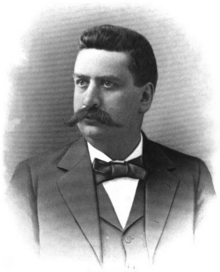| William Brown | |
|---|---|
 | |
| Member-elect of the U.S. House of Representatives from Pennsylvania's 24th district | |
| In office November 3, 1914 – January 31, 1915 | |
| Preceded by | Henry Temple |
| Succeeded by | Henry Temple |
| 8th Lieutenant Governor of Pennsylvania | |
| In office January 20, 1903 – January 15, 1907 | |
| Governor | Samuel W. Pennypacker |
| Preceded by | John P. S. Gobin |
| Succeeded by | Robert S. Murphy |
| Member of the Pennsylvania Senate from the 47th district | |
| In office January 5, 1897 – April 20, 1899 | |
| Preceded by | James Fruit |
| Succeeded by | James Emery |
| Personal details | |
| Born | (1850-09-20)September 20, 1850 Greenville, Pennsylvania, U.S. |
| Died | January 31, 1915(1915-01-31) (aged 64) New York City, New York, U.S. |
| Political party | Republican |
| Signature | |
| a. Brown died before he could be sworn in and seated, though the election results were certified by the House. | |
William M. Brown (September 20, 1850 – January 31, 1915) was a Republican political official from Pennsylvania.
Background
Brown was born in Greenville, Pennsylvania but grew up in Iowa, where his family purchased a farm following the death of his father. In 1869, he moved to New Castle, Pennsylvania and found employment as a bookkeeper for First National Bank. He was admitted to the bar as an attorney in 1876. In 1883, Brown took a job negotiating homesteading contracts for the federal government, which required him to return for two years to Iowa. He moved back to New Castle in 1885, where he opened a department store and helped to finance the city's streetcar line. Brown was soon elected as a Republican to city council.
In 1896, Brown was elected to the Pennsylvania State Senate, serving one term from 1897 to 1899. In 1902, he was elected lieutenant governor, alongside gubernatorial candidate Samuel Pennypacker, and served from 1903 until 1907.
At the end of his term in Harrisburg, Brown returned to New Castle and invested in banking and railroad interests. In 1914 he was elected to the United States House of Representatives, but died from pneumonia in New York City on January 31, 1915, before he was able to take office.
See also
References
- Shimmel, Lewis Slifer. The State Capitol of Pennsylvania, Harrisburg, Nineteen Hundred and Six: "William M. Brown, p. 106. Harrisburg, Pennsylvania: The Harrisburg Telegraph Printing Company, 1906.
- Cochran, Thos. B. and Herman P. Miller, compilers. Smull's Legislative Hand Book and Manual of the State of Pennsylvania: "William M. Brown," p. 124. Harrisburg, Pennsylvania: Wm. Stanley Ray, State Printer of Pennsylvania, 1903.
- Written at New York. "William M. Brown Dies in New York". Times Leader. Wilkes-Barre, Pennsylvania. February 1, 1915. p. 19. Retrieved June 15, 2023 – via Newspapers.com.
External links
- The Political Graveyard
- Lawrence County Memoirs at the Wayback Machine (archived April 22, 2019)
| Party political offices | ||
|---|---|---|
| Preceded byJohn P. S. Gobin | Republican nominee for Lieutenant Governor of Pennsylvania 1902 |
Succeeded byRobert S. Murphy |
| Pennsylvania State Senate | ||
| Preceded byJames Fruit | Member of the Pennsylvania Senate for the 47th district 1897–1899 |
Succeeded byJames Emery |
| Political offices | ||
| Preceded byJohn P. S. Gobin | Lieutenant Governor of Pennsylvania 1903–1907 |
Succeeded byRobert Murphy |
| U.S. House of Representatives | ||
| Preceded byHenry Temple | Member-elect of the U.S. House of Representatives from Pennsylvania's 24th congressional district 1914–1915 |
Succeeded byHenry Temple |
| Lieutenant governors and vice-presidents of Pennsylvania | ||
|---|---|---|
| Vice-presidents (1777–1790) |  | |
| Lieutenant governors (since 1875) | ||